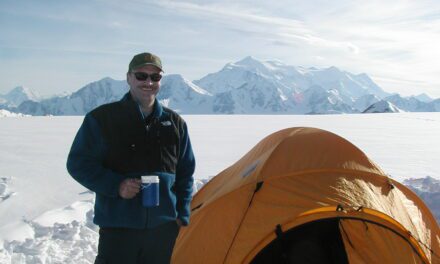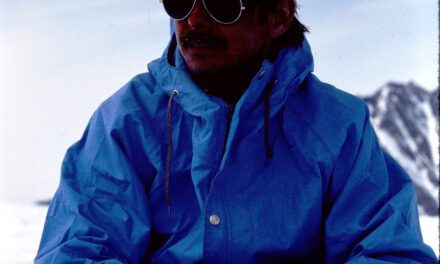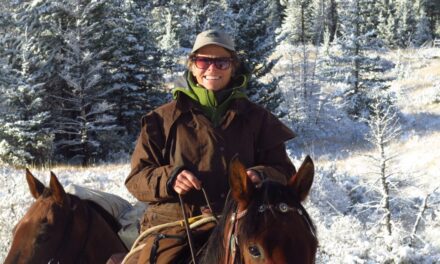(42:49) Lilo – It was just terrible… but the guy was in the ice and probably didn’t feel all the pain…Then a year later, remember the guy came to the Icefields and thanked you. He showed proudly his prosthesis.
(43:15) Hans – Yeah, it was an interesting incident…During that time we had to do that operation it didn’t bother me that much because that was a job that you had to do…Then it dawned on me afterwards when I got back home. I thought, “What the heck have you done?” That wasn’t in my job description.
(44:04) Lilo – It was a terrible thing. But then he has a lot of funny stories also there with Willi Pfisterer. He was such a character also!
“From Mile 45 then did you go to Kluane?”
(44:25) Lilo – Yes we went to Kluane. I didn’t want to go, I loved Jasper. I just loved Jasper! I had tears in my eyes when we left Jasper actually.
“Was it an opportunity to work in public safety?”
Yeah. He had warden schools there. It was an interesting experience, but I wouldn’t want to live there all the time. I also found it quite depressing, those long winters. I cross country skied a lot still, but it was cold. When we left it was the coldest that we have ever experienced in our lives, it was minus 64. For about three weeks it was minus 45 and then minus 50. I remember once…the whole night the trucks were going because otherwise everything would seize up. Animals froze to death, it was brutal, absolutely brutal. I found a lot, a lot of people were drinking up there, alcoholics and so on…If you are not outdoorsy or into nature then I think that is what they go for just to (pass the time). But it was interesting and again summers were wonderful. Those long, long (evenings). At midnight you could read the paper. We were at Kluane Lake camping once and the daylight….
(46:17) Hans – Actually the interesting episodes happened to me during the early years of the warden service. Of course there were a lot of other incidents later on, in later years, but it became much more routine than before because you had to learn the hard way right? As I said before, I was amazed that they gave you the independence to work on your own to the best of your knowledge. And you always came out okay…
(47:15) Hans – I looked after the avalanche control between the Columbia Icefields and Saskatchewan River Crossing. The Icefields were still in Jasper park and Saskatchewan River Crossing that was in Banff park. During the beginning of the 1970s the park warden service was centralized. So most of the station wardens they were pulled in either in Jasper Park to the townsite and the Banff wardens had to go to Lake Louise or to Banff. Then in between that was kind of open. The stations were abandoned, but they still had to look after the avalanche control system. I was the lucky guy who was still the field warden stationed at Mile 45 looking after the avalanche control section. At times this was a relatively easy task depending on the winters of course, how much snow we got and so on. During that time there wasn’t that much traffic on the highway, not as it is today. Anyways I had the Avalauncher, you’ve probably heard of the Avalauncher gun which was a compressed air gun. I used that quite a bit for the lower targets, to shoot the lower targets on Parker’s Ridge and the targets down the highway. We could shoot up to 1000 feet vertically. Because of the way that highway was built, it was built in that side hill. The lower targets were quite active to the heavy slides that…virtually closed the road because that was the way the road was built. So the Avalauncher was actually a very useful tool to shut down the lower targets, but then for the higher targets we had to use the helicopter to drop the bombs….The helicopter you could only use during good weather conditions and that was not always possible because the avalanche hazard is usually the highest during the storm periods when you cannot do anything. But that was well known among everybody else so we had to use the tools we had to do the job. Anyways that 1970/71 winter was one of the heaviest snowfall winters on record and there were a lot, a lot of problems, not only in national parks, it was widespread…That was the time I was stationed at Mile 45 and I had to look after that.
At one time the avalanche hazard got really out of hand. We just had incredible, incredible snowfalls. I phoned the Chief Warden in Jasper and said, “Well, I suggest we close that road because we just cannot keep up.” At that time when I had to do the avalanche control work, I had to get either a warden from Lake Louise or from Jasper to help me run the gun. That usually took a long time for the guys to come onto the scene. It was okay during a mild winter or so, but at this time it was just impossible. So I phoned Jasper. “We should actually close the road.” Then at the same time I phoned Lake Louise and the chief was Andy Anderson. They agreed with that. They said, “Well we should actually close the road. It doesn’t make sense to (keep it open).” Anyways they sent me a warden from Lake Louise to help sweep the road between Saskatchewan River Crossing and the Columbia Icefields. The sweeper came and we closed the gate at Saskatchewan River Crossing and we closed the gate at the Icefields and we swept the road. So the road was swept and it was just continuously snowing, Maintenance hardly could keep up plowing the road anymore and they were glad that the highway was closed.
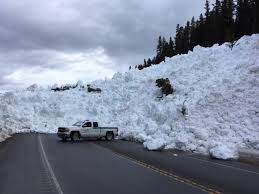
I announced the road was closed and then all of a sudden I got this phone call over the radio. “Hans we have a bus, a Greyhound bus with hockey players. They have to play in Banff tonight could you let them through?” I said, “No way, the road is closed!” “Well, the bus is already on its way.” So they sent this bus. I said, “Why didn’t you send the bus via Edmonton because here there is a big avalanche hazard?” So there we go. Here the bus came to the Icefields about an hour later. I escorted the bus down to Saskatchewan River Crossing and phoned the warden in Lake Louise. “Please open the gate, let the bus through at Bow Summit because it is going to come your way. It was prearranged by Jasper park from management.” The bus came and I got the bus out okay. When I was done at Saskatchewan River Crossing I came back and closed the gate again and said, “Okay the bus is on its way down to Banff. The rest of the guys will look after them and I will go back home, drive up to the Icefields.” When I drove up to the Icefields, here it is a huge big slide across the road. I was trapped behind the big slide at Camp Three. It was huge, it was impossible to drive through that slide, it was just huge. And it was snowing like hell, just lots of snow huh? So what do I do? I turned around and I thought I have to go back to Saskatchewan River Crossing and I have to break into that abandoned warden station. So I drove back and as I drove back all of a sudden I was engulfed in an incredible dust of snow. I realized I was right under a slide path, the Wilson Bowl was running at the same time. Here it was totally dark and I had to stop the truck because I didn’t want to hit the ditch because that would be it, you know. I wouldn’t be mobile anymore. I stopped the truck for a bit and the dust kind of settled. The slide didn’t hit that edge of the road, but there was a lot of dust. I just opened the door to get a little air, when I opened the door it slammed back into my face…The door hit my face so bad I thought, “Oh, my God, here we go.” I drove on then to Saskatchewan River Crossing to the warden station…there was some firewood so I built a fire and warmed up the place. Of course I had no food I just had my lunch still from that day. So I spent the night there and I phoned Banff and Jasper to tell them what happened. But in the meantime, I was really happy that bus with the hockey players made it through Bow Summit and was okay to Banff. In meantime all the slides came down around Bow Summit, all natural releases because of that heavy snow. I was trapped there in the middle of nowhere at Saskatchewan River Crossing, alone in that warden station. I’d go out to go to the truck, to clean the truck and there was another foot of snow on the roof…I couldn’t go either way, I couldn’t go up to the Icefields and I couldn’t go down south because the hazard was too great. I was simply trapped in there. Of course the Chief Park Warden was aware of that in Lake Louise or Banff; that was Andy Anderson…he told me, “We will get you out as soon as we can, just sit tight.” I looked around the kitchen and there was actually a package of banana cake mix. So I made a banana cake, the banana cake lasted me for two days. On the third day, the weather was still (bad) it was totally closed in…I got up and I heard a helicopter flying over Saskatchewan River Crossing above the clouds. I called the helicopter right away and it was actually the helicopter from Valemount who was doing the rescue work for Jasper National Park. It was Garry Forman. He was on his way from Valemount to Rocky Mountain House. He heard my voice over his radio and he said, “Where are you?” I said, “I am down at Saskatchewan River Crossing, I am trapped here at the station.” He said, “Wait a minute, I might be able to get down and get you. There might just be a hole in the clouds that I can go down.” He said, “Yes, I can come and get you. I will be there in five minutes.” I packed up my bags very fast, got out to the truck and stamped out an area for the helicopter to land. And here he comes, the bird comes down from the sky! He landed and gave me a lift up to the Columbia Icefields. We flew alongside the road for a bit and it just looked like a war zone. The whole area was just covered, covered with snow, everywhere there were avalanches down across the road. He got me up to the Columbia Icefields and up there it was clear and better than down below where everything was closed in. I think Lilo picked me up with the VW van at the Columbia Icefields and then we got back home to Mile 45. Since then the road was closed for another two weeks before they could open it. They came up from the Banff side and they came up from the Jasper side from Tangle Creek. The Maintenance Camp was still open…there were huge big walls along the road. Finally the road opened…but that winter wasn’t over yet.
(1:00:16) Hans – Another interesting episode to mention is since that road was reopened again the traffic went freely through back and forth. The winter calmed down for a little bit. But all of a sudden we got another period of heavy, heavy snow. That was about two or three weeks later…It also came to the point where I figured, “Well, we might have to close the road again because it just looks impossible. We cannot (leave) it open, it will just be too dangerous to the public.” So again I phoned the chiefs and said, “I figure we should close the road.” They said, “Okay, it is your decision…” They sent me a fellow up from Lake Louise again. He closed the gate at Saskatchewan River Crossing. I closed the gate up at the Icefields. There were two cars on the road during that road closure. One came from the south, from Lake Louise and one came in from the Columbia Icefields. We told each other we would wait for those cars to come to the gate. Then afterwards we would close the gate and everything was going to be safe, 100%. Those cars just didn’t come. I thought, “What the heck? What the heck? What’s happened?” Those cars still didn’t come. I said, “I have to look for them, so I drove down from the Icefields and sure enough, those two cars were the only two cars on the road for such a long stretch and they collided! They collided in a really, really interesting place in the middle of a slide path. So there we go huh? I thought, “Oh, my God!” I said, “Let’s get out of here and move those people out. One party was from Edmonton and they were actually quite mad that this had happened. I said, “We have to move you out of here, you are in the middle of a slide path that could release at any given time.” I got the people out of the cars and they still asked for a tow truck. I said, “Well, I could get you a tow truck, but we’ve got to get you out of here.” The tow truck had to come from Jasper, a long ways, 100 kilometers. Anyways I got those people out in the truck and a half an hour later the whole avalanche released. The slide came across and covered those two cars collided together…It was a big heap and you only saw two little bumps there. The tow truck was on its way from Jasper, but there was no way he could get through it…Maintenance couldn’t even open the road anymore because there was so much snow falling and there was heavy, heavy snow drifts…I had a skidoo on my truck and whenever I was stuck in the truck at least I could go with the skidoo. For that time that highway was again closed for another two weeks before we could open it up…I took a lot of pictures at that time and I made an avalanche book, an avalanche atlas for Mile 45. Those pictures are still in the avalanche atlas at Mile 45.
“Were you worried about Hans?”
(1:04:34) Lilo – Oh yeah, many, many times!
“Wow, those are some incredible stories.”
(1:04:38) Hans – It was part of the job…As I said, these were actually the most interesting times, the early years.
(1:04:57) Lilo – Tell the other story with Willi there at Edith Cavell, the rescue, that is a funny one.
(1:05:13) Hans – See the search and rescue system started kind of at a slow pace. You had to get the equipment, the proper equipment and the proper training and all that took time. Climbing in the 1960s was so to speak the second era from the first one when the exploration started. So here comes the second era and Parks Canada were of course responsible for search and rescue and the mountaineering accidents, (they had) to look after the welfare of the climbers. One time, I was up at the Icefields still and Willi Pfisterer who was the Alpine Specialist for Jasper and Peter Fuhrmannn was the Alpine Specialist for Banff. Willi Pfisterer radioed me at the Icefields and said, “Hans you have to come up, we have a climber who fell on Mount Sorrow, beside Mount Edith Cavell.” He fell down onto a ledge and he broke his leg. I guess his partner came down to report that. He said, “Drive up to Edith Cavell and we will have another partner for you, so that you can climb up the chimney system up to that climber.” My partner was Abe Loewen who was a young warden at that time. He was very, very eager and as a young guy he actually started to become a really good climber. So Abe Loewen and I went and climbed up to this hurt fellow. Once we got to his position Willi Pfisterer then flew in with the helicopter. He slung…the stretcher to us and we packed the victim into the stretcher and did all the first aid to his leg and made sure everything was okay so that Willi could pick him up. When we had this done, it was slowly getting dark. Willi picked him up and radioed in, he flew with him into the Jasper hospital and came back in… with the sling and he had two harnesses attached to the bottom of that sling, the rescue slings to fly us out, myself and Abe Loewen…We didn’t have harnesses, I had my own climbing harness and I could have probably flown out under the helicopter with that harness. But they were two brand new harnesses and Willi told me over the radio, “Hans, these are two brand new harnesses from the Bavarian Red Cross.” They use those harnesses for rescue operations in Europe…I had never seen those harnesses. So there was Abe Loewen and myself and Abe was very, very eager to use all the new gadgets huh? The harnesses came in and the helicopter was hovering above us, just waiting for us to get into those harnesses because the pilot was very, very eager to get us out of there because it was getting dark. Oh, my God, here are those harnesses and I had no clue how to put them on! There were those rings, there were those carabineers. I had never seen them in my life! We were kind of forced into that situation. I said, “I could fly out, actually in my (climbing) harness, but Abe needed to go into that harness.” So he tried and tried and Willi Pfisterer over the radio said, “Hans, you’ve got to try this, try this gadget and such and such!” I said, “This doesn’t work.” And then Abe said, “Yes, it is going to work! It is going to work!” I said, “Forget it!” I lifted him up and Abe would have gone totally upside down. I thought, “There we go. Here we rescue those two guys and the rescuers come down at the last moment upside down under the helicopter.” I said, “No, I am not going to do this. This is going to be too stupid, too dangerous…” I called the helicopter off and said to Willi, “Look Willi I cannot figure this out, I think it is much safer for us to spend the night on the ledge.”
(1:10:50) Lilo – They weren’t prepared for it.
(1:10:52) Hans – Abe Loewen and I, we spent the night there. We weren’t prepared…because we figured that we were going to be flown out. We spent definitely a cold night up on that ledge! The next day we rapped off (rapelled) down to the teahouse at Edith Cavell. Willi was there puffing his pipe and he said, “You guys have done everything wrong! You should have done this and that!” I said, “Willi, I probably saved your life because I saved your job! We just could not figure it out. So I figured it was much safer to spend the night.” That was interesting and these were all learning experiences. Afterwards it became much more proficient right…It was just an incredible learning experience. We did the best that we could with the tools that we had.
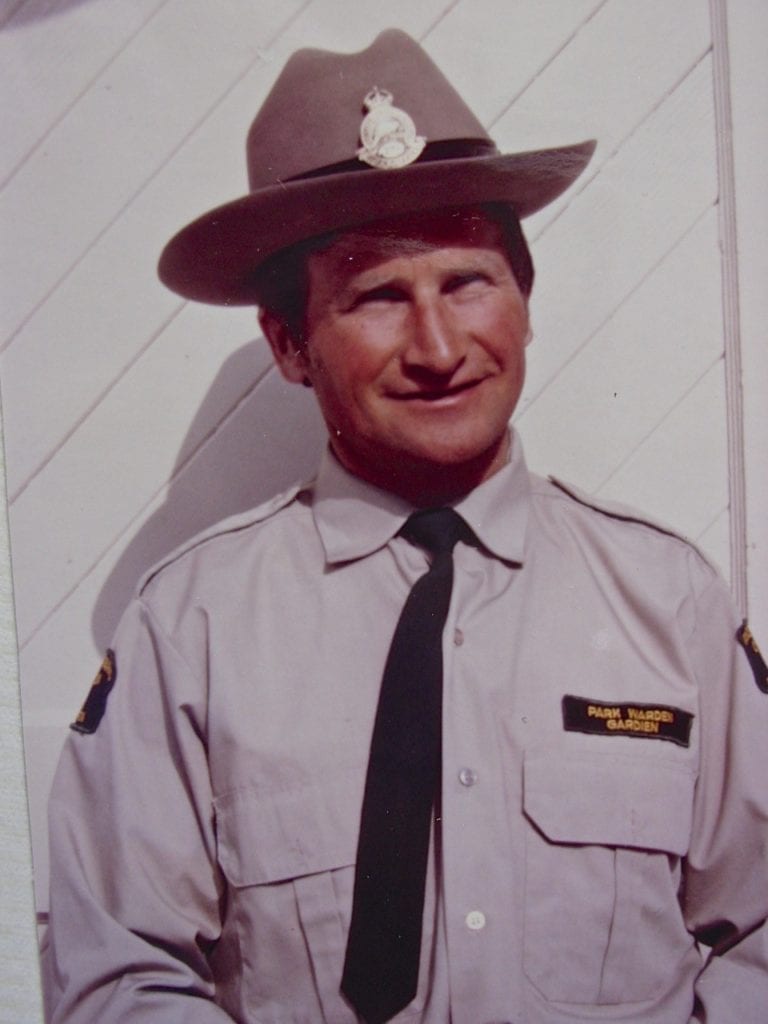
Photo courtesy of Hans & Lilo Fuhrer
How long were you in Kluane?”
(1:12:06) Hans – In Kluane, two years. As a public safety (specialist). Also I climbed Mount Logan at that time…It was actually an interesting climb. The Parks staff up there was Lloyd Freese and Ron Chambers. Ron Chambers was a Yukon native. He had already been down with us at Mile 45 in Jasper and I took him out climbing. He had incredible abilities, natural abilities. He was a real natural outdoor person. So I figured when I was up at Kluane that Ron Chambers would be the right candidate to do Mount Logan and Lloyd Freese. I had a team of three plus a doctor who was from the Arctic Institute who came as far up with us to the King Trench…They had a project up there…it was for high altitude sickness… (It took us) 14 days, I guess. We had a lot, a lot of storms. But it was kind of interesting because we did the summit of Mount Logan and Ron Chambers was that, he was a first nations with the natural abilities, but he was not a climber as such, he couldn’t care less about it. Whether he was down at the lake fishing or up on the mountain. Anyways we climbed Mount Logan and I said, “Well Ron, you made history, you are the first native on the roof of Canada.” He said, “Oh, I would rather be fishing!” That was interesting…Ron Chambers, he probably retired also…

